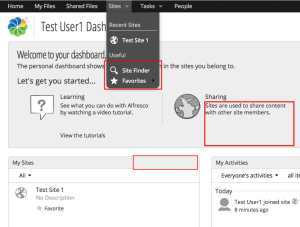There was a small flare-up on the Order of the Bee list this week. It started when someone suggested that the Community Edition (CE) versus Enterprise Edition comparison page on alfresco.com put CE in a negative light. In full disclosure, I collaborated with Marketing on that page when I worked for Alfresco. My goal at the time was to make sure that the comparison was fair and that it didn’t disparage Community Edition. I think it still passes that test and is similar to the comparison pages of other commercial open source companies.
My response to the original post to the list was that people shouldn’t bother trying to get the page changed. Why? Because how Alfresco Software, Inc. chooses to market their software is out-of-scope for the community. As long as the commercial company behind Alfresco doesn’t say anything untrue about Community Edition, the community shouldn’t care.
The fact that there is a commercial company behind Alfresco, that they are in the business of selling Enterprise support subscriptions, and at the same time have a vested interest in promoting the use of Community Edition to certain market segments is something you have to get your head around.
Actually there are a handful of things that you really need to understand and accept so you can be a happy member of the community. Here they are:
1. CE is distributed under LGPLv3 so it is open source.
If you need to put a label on it and you are a binary type of person, this is at the top of the list. Alfresco is “open source” because it is distributed under an OSI-approved license. A more fine-grained description is that it is “open core” because the same software is distributed under two different licenses, with the enterprise version being based on the free version and including features not available in the free version.
2. Committers will only ever be employees.
There have been various efforts over the years to get the community more involved in making direct code contributions. The most recent is that Aikau is on github and accepting pull requests. Maybe some day the core repository will be donated to Apache or some other foundation. Until then, if you want to commit directly to core, send a resume to Alfresco Software, Inc. I know they are hiring talented engineers.
3. Alfresco Software, Inc. is a commercial, for-profit business.
Already mentioned, but worth repeating: The company behind the software earns revenue from support subscriptions, and, increasingly, value-added features not available in the open source distribution. The company is going to do everything it can to maximize revenue. The community needs this to be the case because a portion of those resources support the community product. The company needs the community, so it won’t do anything to aggressively undermine adoption of the free product. You have to believe this to be true. A certain amount of trust is required for a symbiotic relationship to work.
4. “Open source” is not a guiding principle for the company.
Individuals within the company are ardent open source advocates and passionate and valued community members, but the organization as a whole does not use “open source” as a fundamental guiding principle. This should not be surprising when you consider that:
- “Drive Open Innovation” not “Open Source” is a core value to the company as publicly expressed on the Our Values page.
- The leadership team has no open source experience (except John Newton and PHH whose open source experience is Alfresco and Activiti).
- The community team doesn’t exist any more–the company has shifted to a “developer engagement” strategy rather than having a dedicated community leadership or advocacy team.
Accept the fact that this is a software company like any other, that distributes some of its software under an open source license and employs many talented people who spend a lot of their time (on- and off-hours) to further the efforts of the community. It is not a “everything-we-do-we-do-because-open-source” kind of company. It just isn’t.
5. Alfresco originally released under an open source license primarily as a go-to-market strategy
In the early days, open source was attractive to the company not because it wanted help building the software, but because the license undermined the position of proprietary vendors and because they hoped to gain market share quickly by leveraging the viral nature of freely-distributable software. Being open was an attractive (and highly marketable) contrast to the extremely closed and proprietary nature of legacy ECM vendors such as EMC and Microsoft.
I think John and Paul also hoped that the open and transparent nature of open source would lend itself to developer adoption, third-party integrations and add-ons, and a partner ecosystem, which it did.
I think it is this last one–the mismatch between the original motivations to release as open source and what we as a community expect from an open source project–that causes angst. The “open source” moniker attracts people who wish the project was more like an organic open source project than it can or ever will be.
For me, personally, I accepted these as givens a long time ago–none of them bother me any more. I am taking this gift that we’ve been given–a highly-functional, freely-distributable ECM platform–and I’m using it to help people. I’m no longer interested in holding the company to a dogmatic standard they never intended to be held to.
So be cool and do your thing
The “commercial” part of “commercial open source” creates a tension that is felt both internally and externally. Internal tension happens when decisions have to be made for the benefit of one side at the expense of the other. External tension happens when the community feels like the company isn’t always acting in their best interest and lacks the context or visibility needed to believe otherwise.
This tension is a natural by-product of the commercial open source model. It will always be there. Let’s acknowledge it, but I see no reason to antagonize it.
If you want to help the community around Alfresco, participate. Build something. Install the software and help others get it up and running. Join the Order of the Bee. If you want to help Alfresco with its marketing, send them your resume.


